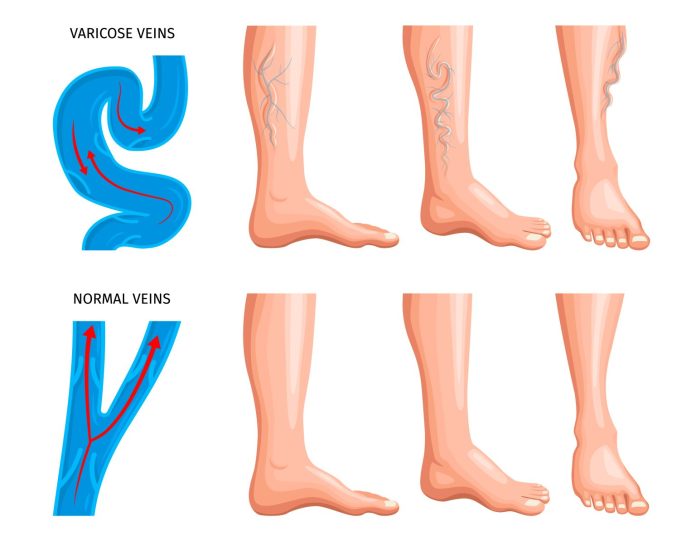While often dismissed as a cosmetic concern, Varicose veins can reveal subtle early signs that should not be ignored. Varicose veins are enlarged, twisted veins that commonly appear in the legs. They result from weakened vein walls and faulty valves, causing blood to pool and veins to swell. Recognising the initial symptoms is important for timely intervention and prevention of potential complications.
The Early Signs and Symptoms
Varicose veins can manifest with subtle yet crucial early signs. One common indicator is the sensation of swelling and heaviness in the legs. Individuals may notice their legs feeling unusually heavy, especially after prolonged periods of standing or sitting. This discomfort often results from compromised blood circulation, leading to the pooling of blood in the veins.
Another early sign is the appearance of spider veins. These are small, twisted blood vessels visible just beneath the surface of the skin. While spider veins themselves may not pose a significant health risk, they can be indicative of underlying venous insufficiency. The intricate network of spider veins may emerge as a response to increased pressure on the veins, signalling the beginning of varicose vein development.
Swelling and heaviness in the legs are often accompanied by a feeling of tightness or cramping, particularly during activities that strain the legs. The discomfort may subside with leg elevation or rest, only to return after prolonged periods of inactivity. Additionally, individuals may notice a change in the colour of their skin around the affected veins.
These early signs should not be dismissed lightly, as they may escalate into more pronounced symptoms if left unattended. Individuals experiencing persistent leg discomfort, swelling, or the emergence of spider veins should consider seeking a vascular specialist promptly. Early intervention may involve lifestyle modifications, such as regular exercise and elevation of the legs or the use of compression stockings.
The Risk Factors
Varicose veins, while influenced by a variety of factors, often have a significant genetic component. Individuals with a family history of the condition are more predisposed to developing it. Genetic factors contribute to the weakening of vein walls and valves, increasing the likelihood of venous insufficiency. Understanding one’s family medical history can serve as an early alert system, prompting proactive measures to mitigate the risk of varicose veins.
Lifestyle factors play a crucial role in the development of the condition. Prolonged periods of standing or sitting can lead to increased pressure on the veins in the lower extremities, impeding blood flow and contributing to the formation of varicose veins. Occupations that involve prolonged standing, such as nursing or teaching, may elevate the risk. Additionally, a sedentary lifestyle with minimal physical activity can compromise overall vascular health. Regular exercise, on the other hand, promotes healthy circulation and helps in preventing its onset.
Gender and age considerations further influence the likelihood of developing varicose veins. Women are more commonly affected than men, and hormonal changes, such as those occurring during pregnancy and menopause, can contribute to vein wall weakening. Age is also a factor, with the risk of development increasing as individuals grow older due to the natural wear and tear on vein walls over time.
Combining these risk factors can amplify the chances of varicose vein development. While genetic predisposition and age are factors beyond control, lifestyle modifications can significantly reduce the risk. Awareness of these risk factors allows individuals to make informed choices, adopting habits that promote vascular health and minimise the likelihood of the condition developing. Regular exercise, maintaining a healthy weight, and avoiding prolonged periods of immobility all contribute to a proactive approach to managing these risk factors.
Self-Examinations
Performing a self-examination is a proactive approach that individuals can adopt to identify potential issues early on. One of the initial steps is to regularly inspect the legs, particularly when standing. Individuals should observe the surface of their legs for any visible signs of enlarged, twisted veins. These may appear bulging or rope-like and could be accompanied by discolouration of the skin around the affected area.
Changes in the appearance of veins are a key aspect of self-examination. Healthy veins typically appear as thin blue or green lines beneath the skin. However, the development of varicose veins can lead to a noticeable change in this pattern. Individuals should pay attention to the emergence of spider veins, clusters of small, web-like veins that may indicate venous insufficiency. Additionally, any visible swelling or distortion in the usual vein pattern warrants attention.
Monitoring symptoms like pain and discomfort is crucial in self-examination. Varicose veins often cause aching or throbbing sensations in the legs, particularly after prolonged periods of standing or sitting. Individuals should take note of any persistent discomfort, cramping, or a feeling of heaviness in the legs. Consistent pain or discomfort may suggest compromised blood flow and the potential development of varicose veins.
Regular self-checks should also involve palpation, or gently pressing on different areas of the legs to detect tenderness or swelling. Any tenderness or swelling, especially along the path of a vein, could be indicative of the condition developing.
Incorporating self-examinations into one’s routine provides an opportunity for early detection and intervention. Recognising these changes allows individuals to consult with healthcare professionals promptly where varicose veins treatment may be pursued, potentially preventing their progression.
Detecting the onset of varicose veins through recognising the early signs and symptoms, understanding risk factors and self-examinations is vital for timely intervention and preventing potential complications. Individuals who are concerned should always consult with medical professionals.





